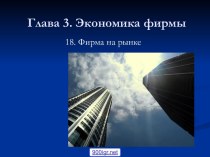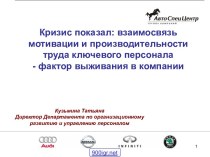- Главная
- Разное
- Бизнес и предпринимательство
- Образование
- Развлечения
- Государство
- Спорт
- Графика
- Культурология
- Еда и кулинария
- Лингвистика
- Религиоведение
- Черчение
- Физкультура
- ИЗО
- Психология
- Социология
- Английский язык
- Астрономия
- Алгебра
- Биология
- География
- Геометрия
- Детские презентации
- Информатика
- История
- Литература
- Маркетинг
- Математика
- Медицина
- Менеджмент
- Музыка
- МХК
- Немецкий язык
- ОБЖ
- Обществознание
- Окружающий мир
- Педагогика
- Русский язык
- Технология
- Физика
- Философия
- Химия
- Шаблоны, картинки для презентаций
- Экология
- Экономика
- Юриспруденция
Что такое findslide.org?
FindSlide.org - это сайт презентаций, докладов, шаблонов в формате PowerPoint.
Обратная связь
Email: Нажмите что бы посмотреть
Презентация на тему Depreciation and Income Taxes
Содержание
- 2. ObjectiveThe objective is to introduce some of
- 3. General AccountingGeneral Accounting:Preparation of financial statements for
- 4. General AccountingBalance sheet:Static picture of assets, liabilities
- 5. It is comprised of the following 3
- 6. Balance Sheet Sample
- 7. General AccountingProfit and loss statement:Also called “income
- 8. Income StatementIncome Statement is composed of the
- 9. Cost AccountingCosts incurred to produce and sell
- 10. Direct CostsDirect material:Material whose cost is directly
- 11. Manufacturing CostsFactory Overhead:Indirect labor costs (sick leaves,
- 12. Administrative and Selling CostsAdministrative costs:Salaries of executive
- 13. Depreciation As time passes, the assets lose
- 14. DEPRECIATIONDecrease in value of physical properties with
- 15. PROPERTY IS DEPRECIABLE IF IT MUST :be
- 16. DEPRECIABLE PROPERTYTANGIBLE - can be seen or
- 17. WHEN DEPRECIATION STARTS AND STOPSDepreciation starts when
- 18. DEPRECIATION CONCEPTSThe following terms are used in
- 19. Value of an assetMarket valueThe actual value
- 20. Book ValueLet:P = adjusted cost basisBVt =
- 21. Capital versus expenseConsider a copy shop, which
- 22. Capital versus expenseCopying (Xerox) machines are used
- 23. DefinitionsCapital gains:Item selling price greater than purchase
- 24. ExampleIf at the end of 1 yearI
- 25. Salvage valueIf a salvage value is expected,Depreciation
- 26. Depreciation and taxesDepreciation is treated as an
- 27. ObservationsDepreciation methods are conventionsNot based strictly on
- 28. Some Depreciation SchedulesStraight line method (SL)Declining Balance
- 29. SL DepreciationConstant rate of loss in the
- 30. SL depreciationRecovery period = nDepreciation rate =
- 31. SL Depreciation – Cont.Dsl(t) = (P-SV) /
- 32. Example 1Small computers purchased by a company
- 33. Example 1 – Cont.Dsl(1) = Dsl(2) =
- 34. Example 2A machine tool has:First cost $35,000Recovery
- 35. In table form …BV in year n = 1st cost – (SL Deprec)*n
- 36. Straight line depreciationWrites off capital investment linearlyEstimated
- 37. Declining Balance DepreciationSometimes called constant percentage method
- 38. DB DepreciationD(1) = P × dD(2) =
- 39. DB DepreciationD1 = P × dDdb (t)
- 40. Example 3: Example 1 revisitedUse a depreciation
- 41. Double declining balance (DDB)Most common form of
- 42. Example 4: example 2 revisitedConsider the same
- 43. In table form
- 44. DDB With Conversion to SL at the
- 45. Example: DB Switching to SL SL Dep.
- 46. (a) Without switching(b) With switching to SLNote:
- 47. Case 2: S = $2,000Note: Tax law
- 48. Sum-of-Years’ Digits (SYD) Method PrincipleDepreciation concept similar
- 49. Example 10.7 – SYD methodD1D2D3D4B1B2B3B4B5$10,000 $8,000 $6,000
- 50. Units-of-Production Method Principle Service units will be consumed
- 51. See Example 7-4 A piece of
- 52. DepletionTwo methods of natural resource depletion Cost or factor depletion Percentage depletion
- 53. Cost DepletionDepletion is computed on a per
- 54. Cost Depletion: An ExampleSuppose a reservoir contains
- 55. Percentage Depletion Percentage depletion Depletion is computed
- 56. Percentage Depletion Allowances for Mineral Properties
- 57. Percentage Depletion: An ExampleAssume in the previous
- 58. Percentage Depletion: An ExampleGross Depletion Income =
- 59. Agenda for todayWe will learn how to
- 60. Agenda for todayReview terms and definitionsRate of return (ROR)Tax deductionTax creditCapital gain/lossCharity deductionsBondsExamples
- 61. Why do we calculate depreciation?Since depreciation is
- 62. DefinitionsNet versus gross income:Gross income = revenue
- 63. How to calculate After-Tax Cash Flow?Determine before-tax
- 64. Taxable Income and Income Taxes (An Example)
- 65. General table …Assume first cost=120, revenue=32, SL dep, SV=0, tax=40%
- 66. ObservationsLand is capitalLand purchase is not an
- 67. Depreciation example (SL)Investment with depreciationBuy equipment for
- 68. Depreciation example (SL)SL Deprec. = (110-0)/10 =
- 69. Longer depreciation (25 years) What would you
- 70. Comparison10 year (SL) depreciation schedule:Rate of return
- 71. Accelerated depreciation 7 year depreciation lifetime:Double declining
- 72. Accelerated depreciation
- 73. Accelerated depreciationHow to figure out after-tax IRR?Use
- 74. Net Income vs. Cash FlowNet income is
- 75. Why Do We Use Cash Flow in
- 76. Example: Cash Flow vs. Net Income
- 77. Net income versus net cash flowNet cash flows = Net income + non-cash expense (depreciation)
- 78. DefinitionsTax deduction:Expense deducted from taxable incomeSaving =
- 79. DefinitionsBook value: Purchase price (for land, stocks,
- 80. DefinitionsCapital gains:Item selling price greater than purchase
- 81. Capital gain/lossGenerally attributed to year of saleLong-term
- 82. Capital gain/lossCarrying backward or forward:Some businesses are
- 83. ExampleInvestment with depreciationBuy equipment for $110K for 10 years:No salvage valueStraight-line depreciation
- 84. ExampleSell for $30K in year 8:Book value
- 85. Non-depreciable exampleInvestment with no depreciationBuy land for
- 86. Capital gain/lossTaxable income = Gross income (i.e.,
- 87. Personal income taxSame general issues as corporate
- 88. Tax-exempt examplePurchase $5K bond (20 years)From phone
- 89. Tax-exempt examplePhone company bond at 11%:$550/year, paid
- 90. ObservationA government bond (tax-exempt) at 7.5% may
- 91. Charitable deduction exampleAssume the following tax rate:tax
- 92. Graduated income taxConstant tax rate:“Flat tax”If tax rate is not constant:“Graduated” income tax
- 93. Graduated income taxExample:15% if taxable income <
- 94. Example - Corporate Income TaxesFacts:Capital expenditure $100,000(allowed depreciation)
- 95. Example - Corporate Income TaxesTaxable income: Gross income $1,250,000 -
- 96. Average tax rate: Total taxes = $112,730 Taxable income = $332,000
- 97. U.S. Corporate Tax Rate (2001)Taxable income0-$50,000$50,001-$75,000$75,001-$100,000$100,001-$335,000$335,001-$10,000,000$10,000,001-$15,000,000$15,000,001-$18,333,333$18,333,334 and
- 98. Marginal and Effective (Average) Tax Rate for a Taxable Income of $16,000,000
- 99. How to Determine Income Tax Rate to be Used in Economic Analysis?
- 100. Incremental Income Tax RateAverage tax rate
- 101. $0$20,000 incrementaltaxable income due toundertaking project
- 102. Скачать презентацию
- 103. Похожие презентации
ObjectiveThe objective is to introduce some of the concepts and mechanics of depreciation and depletion, some historical depreciation methods, as well illustrate different types of taxes




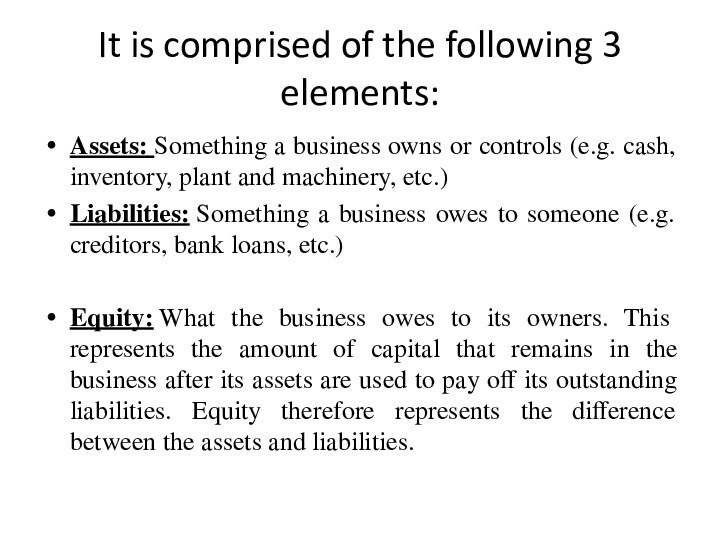











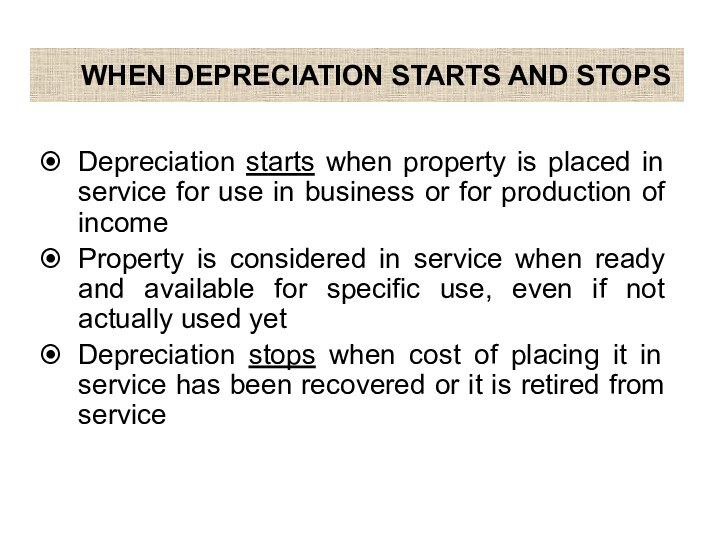
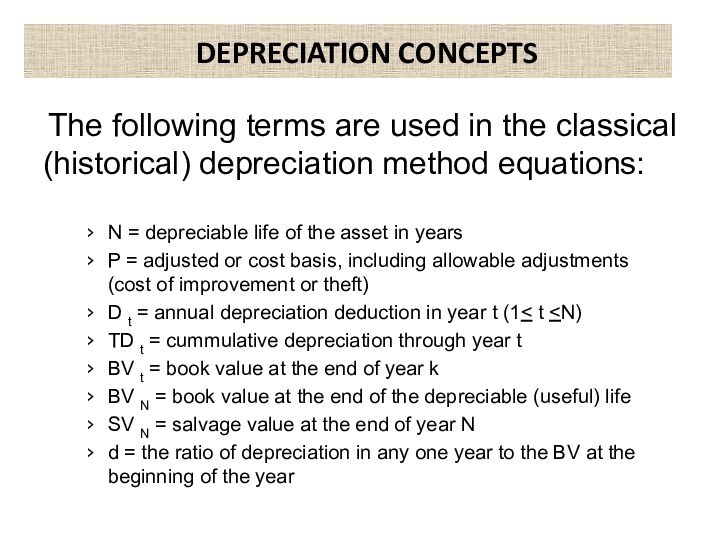






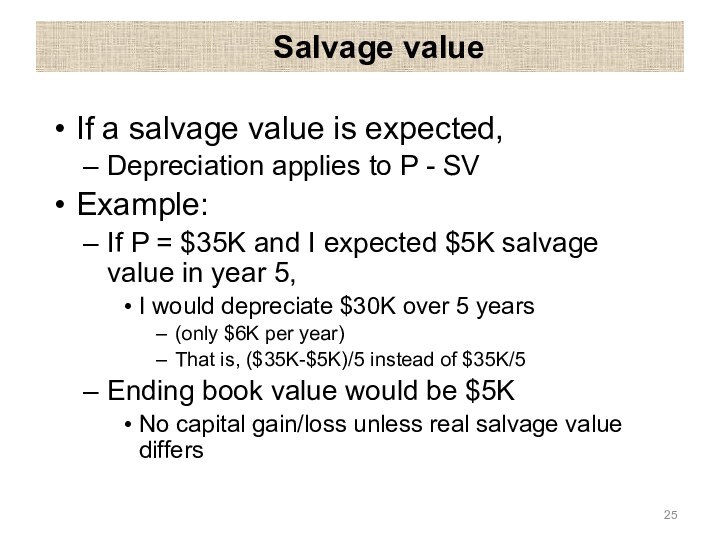


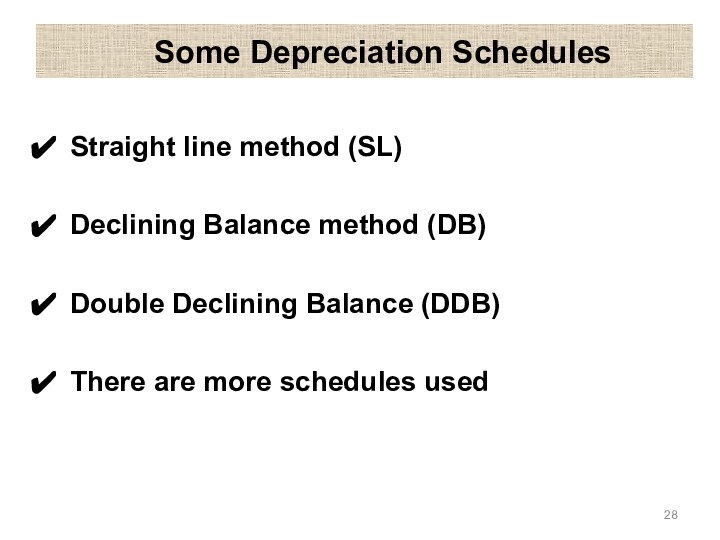

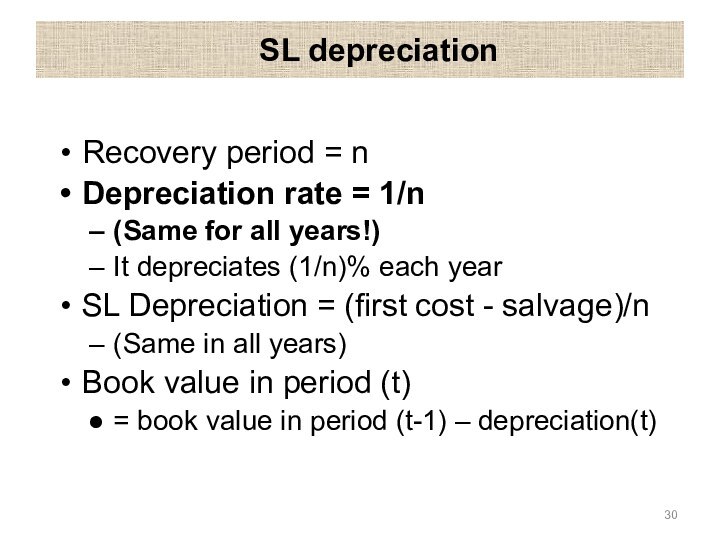
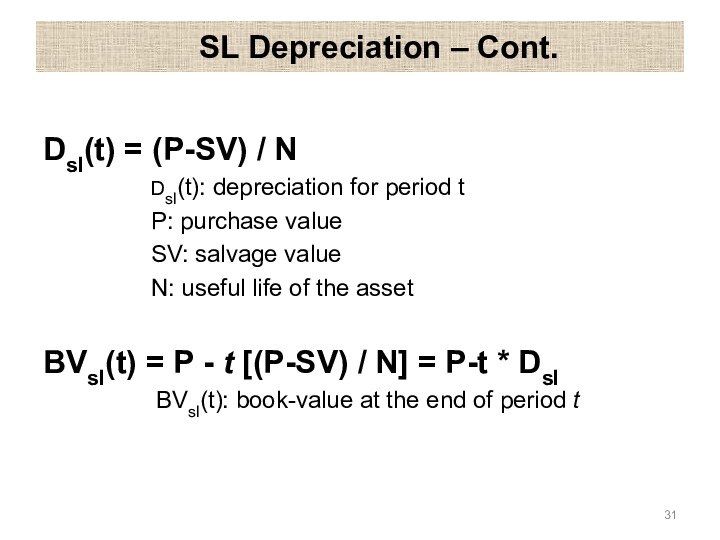



















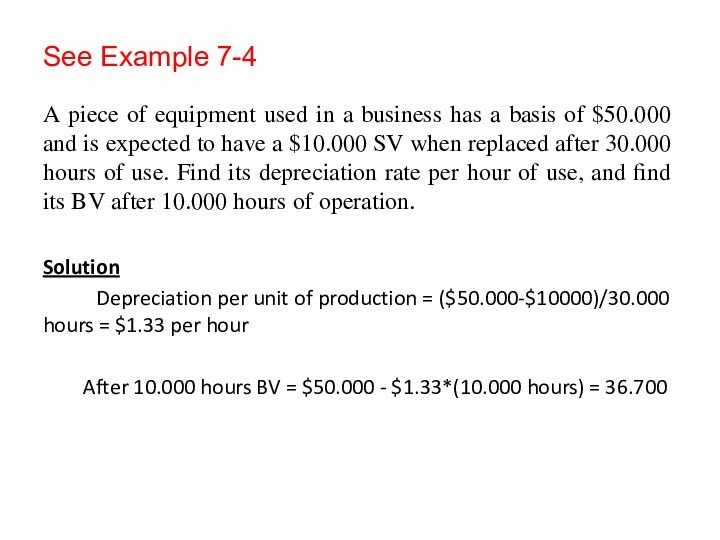
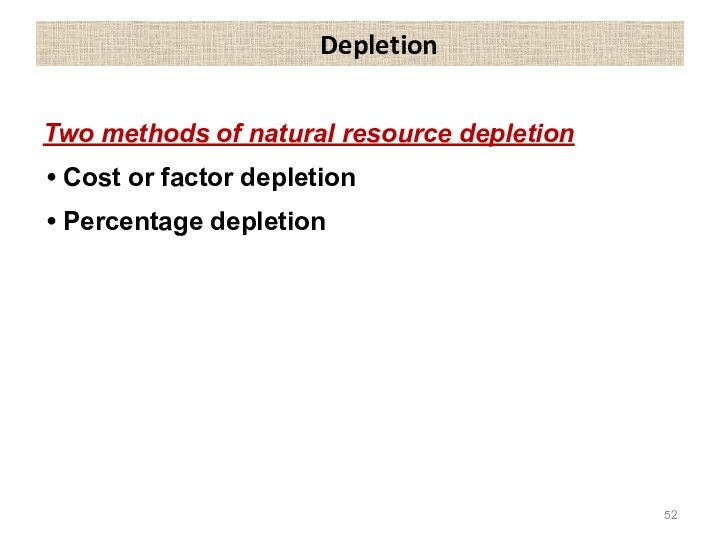

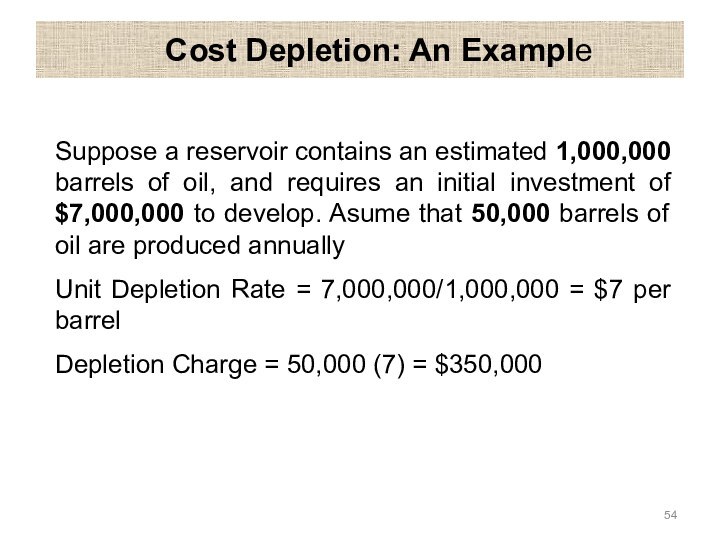


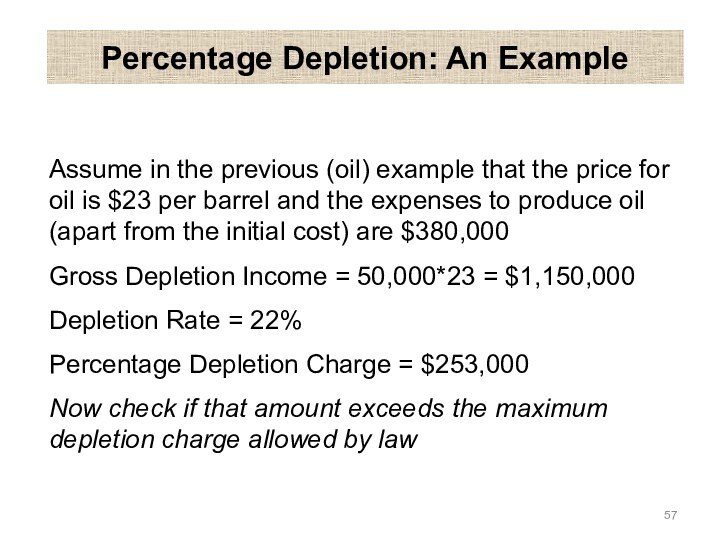





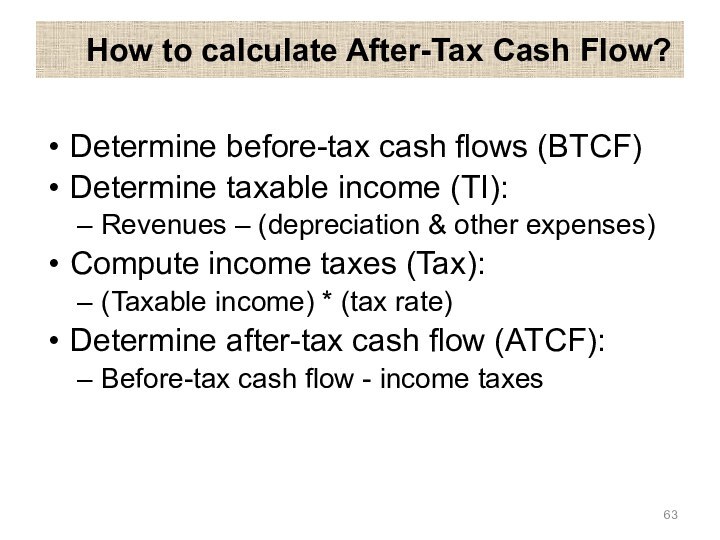
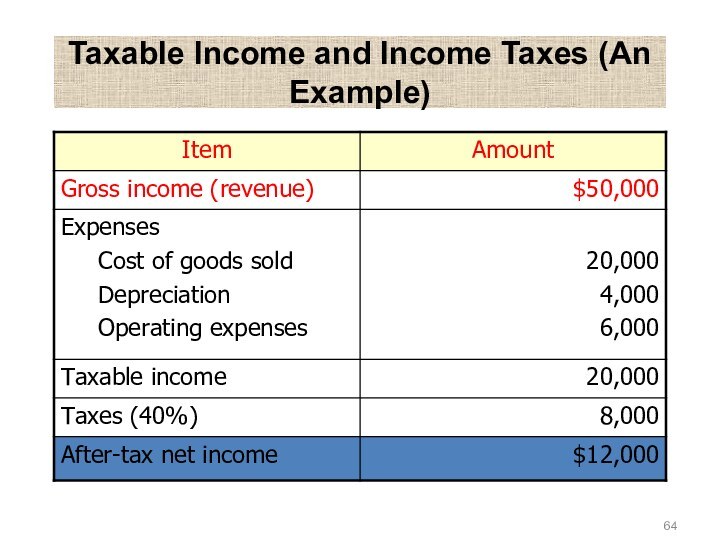












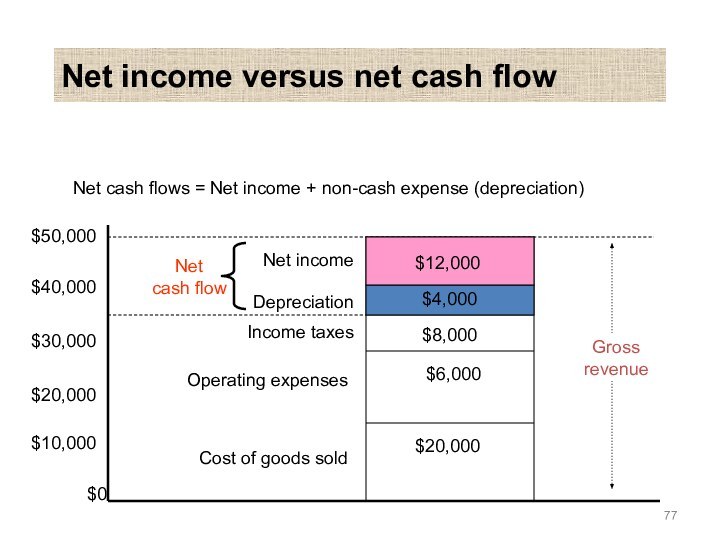






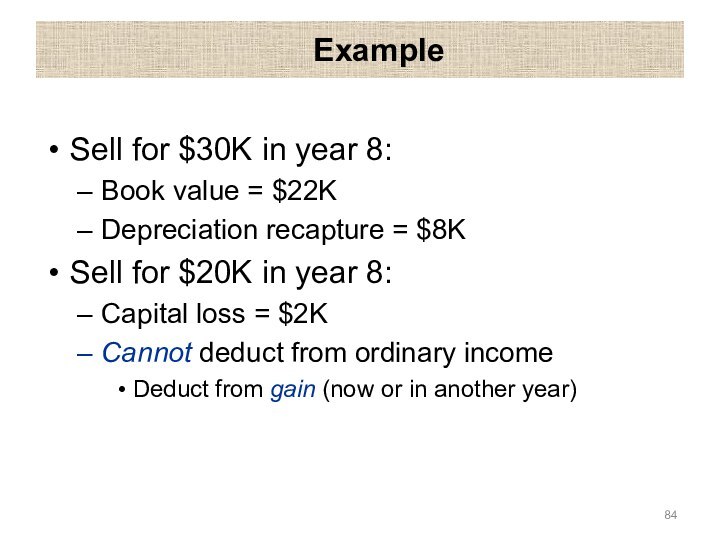



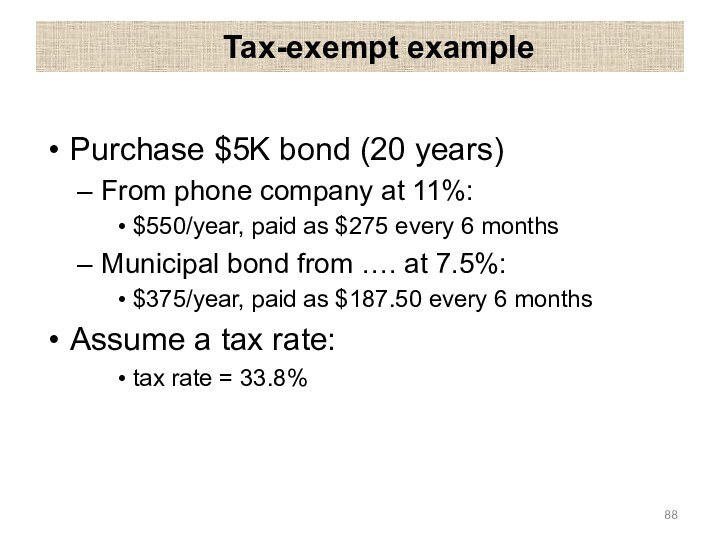
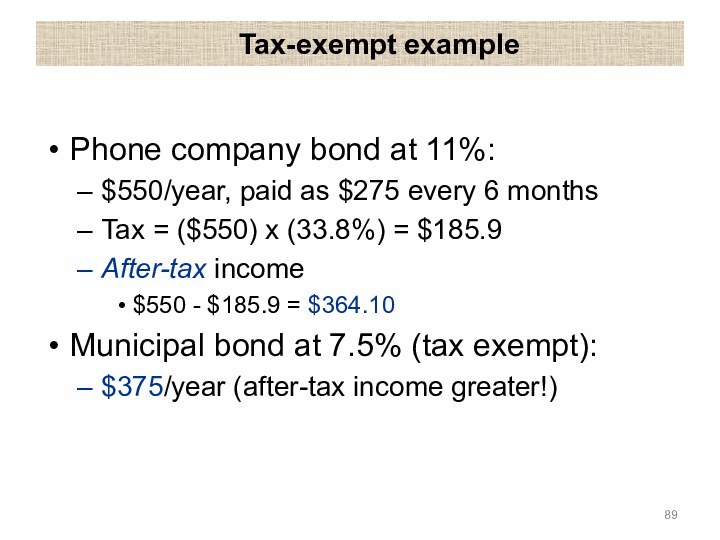













Слайд 3
General Accounting
General Accounting:
Preparation of financial statements for a
firm. A financial statement (or financial report) is a formal record of
financial activities of a business, person, or other entityCost Accounting:
A branch of general accounting that deals with the measurement of costs
Depreciation Accounting:
A branch of general accounting that deals with capital assets depreciation
Слайд 4
General Accounting
Balance sheet:
Static picture of assets, liabilities and
net worth at a single point in time or
a summary of financial balances of a corporationAssets, liabilities and ownership equity (or shareholder’s equity = initial amount of money invested into a business) are listed as of a specific date, such as the end of its financial year. A balance sheet is often described as a "snapshot of a company's financial condition"
Слайд 5
It is comprised of the following 3 elements:
Assets: Something
a business owns or controls (e.g. cash, inventory, plant
and machinery, etc.)Liabilities: Something a business owes to someone (e.g. creditors, bank loans, etc.)
Equity: What the business owes to its owners. This represents the amount of capital that remains in the business after its assets are used to pay off its outstanding liabilities. Equity therefore represents the difference between the assets and liabilities.
Слайд 7
General Accounting
Profit and loss statement:
Also called “income statement”
Income
Statement reports the company's financial performance in terms of
net profit or loss over a specified period.
Слайд 8
Income Statement
Income Statement is composed of the following
two elements:
Income: What the business has earned over a
period (e.g. sales revenue, dividend income, etc.)Expense: The cost incurred by the business over a period (e.g. salaries and wages, depreciation, rental charges, etc.)
Net profit or loss is arrived by deducting expenses from income.
Слайд 9
Cost Accounting
Costs incurred to produce and sell an
item or product are classified as:
Direct labor
Direct material
Manufacturing cost
Administrative
costSelling cost
Слайд 10
Direct Costs
Direct material:
Material whose cost is directly charged
to a product
Measured as the sum of charges for
materials necessary to produce the productDirect labor:
Labor cost directly attributable to a product
Measured by multiplying direct labor hours by the hourly wage rate
Слайд 11
Manufacturing Costs
Factory Overhead:
Indirect labor costs (sick leaves, vacations,
bonuses as well as labor connected to inspection, cleaning…)
Indirect
material costs (costs of materials that cannot be attributed to a particular product)Fixed costs (taxes, insurance, depreciation, maintenance)
Factory Costs are the sum of:
Direct labor costs
Direct material costs
Factory overhead
Слайд 12
Administrative and Selling Costs
Administrative costs:
Salaries of executive and
clerical personnel, office space, traveling, auditing, necessary to direct
the whole enterprise (not just its production or selling activities)Selling costs
Any expense involved in selling the products or services that tie in directly with sales (selling commissions, market surveys, selling bags, advertising)
Слайд 13
Depreciation
As time passes, the assets lose value
or depreciate
Physical loss
Use related
Time related
Functional loss
Efficiency (technology) related
Demand (changing
tastes) relatedCapacity related
Слайд 14
DEPRECIATION
Decrease in value of physical properties with passage
of time and use
Accounting concept establishing annual deduction against
before-tax income- to reflect effect of time and use on asset’s value in firm’s financial statement
Слайд 15
PROPERTY IS DEPRECIABLE IF IT MUST :
be used
in business or held to produce income
have a determinable
useful life which is longer than one yearwear out, decay, get used up, become obsolete, or lose value from natural causes
not be inventory, stock in trade, or investment property
Слайд 16
DEPRECIABLE PROPERTY
TANGIBLE - can be seen or touched
personal property - includes assets such as machinery,
vehicles, equipment, furniture, etc...real property - anything erected on, growing on, or attached to land
(Since land does not have a determinable life itself, it is not depreciable)
INTANGIBLE - personal property, such as copyright, patent or franchise (out of scope of the lecture)
Слайд 17
WHEN DEPRECIATION STARTS AND STOPS
Depreciation starts when property
is placed in service for use in business or
for production of incomeProperty is considered in service when ready and available for specific use, even if not actually used yet
Depreciation stops when cost of placing it in service has been recovered or it is retired from service
Слайд 18
DEPRECIATION CONCEPTS
The following terms are used in the
classical (historical) depreciation method equations:
N = depreciable life of
the asset in yearsP = adjusted or cost basis, including allowable adjustments (cost of improvement or theft)
D t = annual depreciation deduction in year t (1< t
BV t = book value at the end of year k
BV N = book value at the end of the depreciable (useful) life
SV N = salvage value at the end of year N
d = the ratio of depreciation in any one year to the BV at the beginning of the year
Слайд 19
Value of an asset
Market value
The actual value an
asset can be sold for
Book value
The depreciated value
of an asset as shown on the accounting records of company. Not a useful measure of its market value Salvage value
Actual value of an asset at the end of its useful life. It is the expected selling price of a property when the asset can no longer be used productively by its owner
Слайд 20
Book Value
Let:
P = adjusted cost basis
BVt = book
value at the end of period t
Dt = depreciation
during period t Then:
BVt = BVt-1 – Dt
BVt = P - ∑jt=1 Dt
Слайд 21
Capital versus expense
Consider a copy shop, which buys:
Ink
and paper
Copying (Xerox) machines
Ink and paper are used up
when they are bought (for all practical purposes):Treated as an expense
When company buys/uses $1000 of paper,
It is $1000 poorer (not counting any revenue)!
Слайд 22
Capital versus expense
Copying (Xerox) machines are used up
only slowly over time:
Treated as “capital goods”
When company buys
a $1000 machine It trades $1000 cash for $1000 in equipment
Not poorer at all! (assets just changed form)
That is why expenses can be deducted from the income fully and instantly, assets or capital need to be depreciated
Слайд 23
Definitions
Capital gains:
Item selling price greater than purchase price
Depreciation
recapture:
Item selling price greater than book value
(Up to purchase
price)Taxed as ordinary income
Capital loss:
Item sold for less than book value
Слайд 24
Example
If at the end of 1 year
I go
out of business and sell my tools for $40K.
I bought them for $35K and Book Value=$25
How much capital gain (or loss) do I have?
If at the end of 5 years
I go out of business and sell my tools for $5K
I bought them for $35K and Book Value=$10
How much capital gain (or loss) do I have?
Note that book value may be 0 even when market value is positive!
Слайд 25
Salvage value
If a salvage value is expected,
Depreciation applies
to P - SV
Example:
If P = $35K and I
expected $5K salvage value in year 5,I would depreciate $30K over 5 years
(only $6K per year)
That is, ($35K-$5K)/5 instead of $35K/5
Ending book value would be $5K
No capital gain/loss unless real salvage value differs
Слайд 26
Depreciation and taxes
Depreciation is treated as an expense
(i.e.,
a tax deduction) in computation of income taxes
It is
a fictitious expense!No cash changes hands
Would you rather have that “expense” occur sooner or later?
Слайд 27
Observations
Depreciation methods are conventions
Not based strictly on market
value!
Different types of assets have:
Different recovery periods
(Only partially
related to actual lifetime)Different allowable depreciation schedules
(Usually codified in lookup tables)
Слайд 28
Some Depreciation Schedules
Straight line method (SL)
Declining Balance method
(DB)
Double Declining Balance (DDB)
There are more schedules used
Слайд 29
SL Depreciation
Constant rate of loss in the value
of an asset
Graphically: straight line between the first
cost and the salvage or scrap value of the asset0
8
200
800
Years
Book Value ($)
Слайд 30
SL depreciation
Recovery period = n
Depreciation rate = 1/n
(Same
for all years!)
It depreciates (1/n)% each year
SL Depreciation =
(first cost - salvage)/n(Same in all years)
Book value in period (t)
= book value in period (t-1) – depreciation(t)
Слайд 31
SL Depreciation – Cont.
Dsl(t) = (P-SV) / N
Dsl(t):
depreciation for period t
P: purchase value
SV: salvage value
N: useful
life of the assetBVsl(t) = P - t [(P-SV) / N] = P-t * Dsl
BVsl(t): book-value at the end of period t
Слайд 32
Example 1
Small computers purchased by a company cost
$7000 each. Past records indicate that they should have
a useful life of 5 years, after which they will be disposed of, with no salvage value. Determine:The depreciation charge during year 1
The depreciation charge during year 2
The book value of the computers at the end of year 3
Слайд 34
Example 2
A machine tool has:
First cost $35,000
Recovery period
20 years
(based on estimated life)
Estimated salvage value $3,500
Depreciation
= ($35,000 - $3,500)/20= $1,575 (same in all years)
Слайд 36
Straight line depreciation
Writes off capital investment linearly
Estimated salvage
value is considered:
Only estimated!
Actual (future) salvage value is not
known when depreciation schedule is setSL Depreciation gives you a constant amount each year
Слайд 37
Declining Balance Depreciation
Sometimes called constant percentage method or
Matheson formula: assumes that the annual cost of depreciation
is a fixed percentage of the BV at the beginning of the yearConstant proportion loss in value of an asset
Depreciation rate: a constant percentage
Ddb (t) = BVdb(t - 1) × d
Ddb (t): depreciation amount in period t
BVdb (t): book value at the end of period t
P: purchase price
d: depreciation rate
Слайд 38
DB Depreciation
D(1) = P × d
D(2) = d
× (P- D(1)) = P(1-d) × d
D(3) = d
× (P- D(1)-D(2)) = P(1-d)2 × d…
…
Ddb (t) = P(1-d)t-1 × d
Слайд 39
DB Depreciation
D1 = P × d
Ddb (t) =
P(1-d)t-1 × d
Ddb (t) = BVdb(t - 1) ×
dBVdb(t) = BVdb(t-1) - Ddb(t) = BVdb(t-1) (1-d)
BVdb(t) = P(1-d)t
Слайд 40
Example 3: Example 1 revisited
Use a depreciation rate
of 40% for declining-balance method. Consider the previous example
1Ddb(1) = BV(0) * (0.4) = 7000 (0.4) = $2800
Ddb(2) = BV(1) * (0.4) = (7000–2800) (0.4)
Ddb(2) = $1680
BVdb(3) = 7000 (1-0.4)3 = $1512
Слайд 41
Double declining balance (DDB)
Most common form of declining
balance is double declining balance or 200% declining balance
(it would have been the triple and more, if the law permitted it, but the double was the maximum rate allowed):d = 2/n, where n = recovery period
Слайд 42
Example 4: example 2 revisited
Consider the same machine
tool
d = 2/20 years
= 10% per year (or
0.1)Depreciation in year 1 = 0.1($35,000)
We use $35,000 since that is the BV in year 0
= $3,500 (versus $1,575 for straight line)
Depreciation in year 2
= 0.1 (BV in t-1)
= 0.1 ($35,000 - $3,500) = $3,150, etc.
Слайд 44 DDB With Conversion to SL at the Most
Desirable Time
Since DDB does not use a value for
Salvage, we have three possible scenarios at time of disposal:Over depreciation: Book Value < Salvage Value. Tax savings realized early. Small gain upon sale of the asset and taxes on the gain.
Exact depreciation: Book value = Salvage value. There are no tax consequences upon sale of the asset.
Under depreciation: Book Value > Salvage Value. Did not deduct as much as you could have and lost tax savings.
To allow companies take advantage of all the depreciation charges they are entitled to, they can switch from DDB to straight line at the most favorable time.
Слайд 45
Example: DB Switching to SL
SL Dep. Rate
= 1/5
a (DDB rate) = (200%) (SL rate)
= 2/5Depreciation Base $10,000
Salvage Value 0
Depreciation 200% DB
Depreciable life 5 years
Слайд 46
(a) Without switching
(b) With switching to SL
Note: Without
switching, we have not depreciated the entire cost of
the asset and thus have not taken full advantage of depreciation’s tax deferring benefits.Case 1: S = 0
Слайд 47
Case 2: S = $2,000
Note: Tax law does
not permit us to depreciate assets below
their salvage values.
Слайд 48
Sum-of-Years’ Digits (SYD) Method
Principle
Depreciation concept similar to
DB but with decreasing depreciation rate.
Charges a larger fraction
of the cost as an expense of the early years than of the later years.Formula
Annual Depreciation
Book Value
where SYD=N(N+1)/2
Слайд 49
Example 10.7 – SYD method
D1
D2
D3
D4
B1
B2
B3
B4
B5
$10,000
$8,000
$6,000
$4,000
$2,000
0
0 1
2 3 4 5 Total depreciation at end of life
P = $10,000
N = 5 years
S = $2,000
SOYD = 15
n
Слайд 50
Units-of-Production Method
Principle
Service units will be consumed in
a non time-phased fashion (decrease in value of property
is a function of use and not function of time)Formula
Dper unit =
Estimated lifetime production units
See Example 7-4
Слайд 51
See Example 7-4
A piece of equipment used
in a business has a basis of $50.000 and
is expected to have a $10.000 SV when replaced after 30.000 hours of use. Find its depreciation rate per hour of use, and find its BV after 10.000 hours of operation.Solution
Depreciation per unit of production = ($50.000-$10000)/30.000 hours = $1.33 per hour
After 10.000 hours BV = $50.000 - $1.33*(10.000 hours) = 36.700
Слайд 52
Depletion
Two methods of natural resource depletion
Cost or
factor depletion
Percentage depletion
Слайд 53
Cost Depletion
Depletion is computed on a per unit
basis
Per unit amount is determined by dividing the basis
of the resource (FC) by the estimated recoverable units of resourceNumber of units sold in year × per unit depletion = depletion for year
Total depletion can not exceed total cost of the property
Слайд 54
Cost Depletion: An Example
Suppose a reservoir contains an
estimated 1,000,000 barrels of oil, and requires an initial
investment of $7,000,000 to develop. Asume that 50,000 barrels of oil are produced annuallyUnit Depletion Rate = 7,000,000/1,000,000 = $7 per barrel
Depletion Charge = 50,000 (7) = $350,000
Слайд 55
Percentage Depletion
Percentage depletion
Depletion is computed by
using the statutory percentage rate for the type of
resourceRate is applied to the gross income from the property
Percentage depletion
Percentage depletion cannot exceed 50% of the taxable income (before depletion) from the property
Percentage depletion reduces basis in property
However, total percentage depletion may exceed the total cost of the property
Слайд 57
Percentage Depletion: An Example
Assume in the previous (oil)
example that the price for oil is $23 per
barrel and the expenses to produce oil (apart from the initial cost) are $380,000Gross Depletion Income = 50,000*23 = $1,150,000
Depletion Rate = 22%
Percentage Depletion Charge = $253,000
Now check if that amount exceeds the maximum depletion charge allowed by law
Слайд 58
Percentage Depletion: An Example
Gross Depletion Income =
$1,150,000
Less expenses =
- $380,000$770,000
Deduction Limitation 50%
Maximum Depletion Charge $385,000
$253,000 < $385,000, so full charge is allowable
Слайд 59
Agenda for today
We will learn how to determine:
Before-tax cash flows
Taxable income
Income taxes
After-tax cash flow
We will
see the effects of depreciation schedule on after-tax IRRExamples
Слайд 60
Agenda for today
Review terms and definitions
Rate of return
(ROR)
Tax deduction
Tax credit
Capital gain/loss
Charity deductions
Bonds
Examples
Слайд 61
Why do we calculate depreciation?
Since depreciation is an
“expense” we can use that expense to reduce our
taxable income, and therefore reduce the amount of taxes we pay.We have to know how much our equipment has depreciated to determine the deductions to be made.
Слайд 62
Definitions
Net versus gross income:
Gross income = revenue or
receipts
Net income = revenue minus expenses
Corporate tax is on
net income (profit)Individual tax is on gross income
Income taxes are an additional expense
Слайд 63
How to calculate After-Tax Cash Flow?
Determine before-tax cash
flows (BTCF)
Determine taxable income (TI):
Revenues – (depreciation & other
expenses)Compute income taxes (Tax):
(Taxable income) * (tax rate)
Determine after-tax cash flow (ATCF):
Before-tax cash flow - income taxes
Слайд 66
Observations
Land is capital
Land purchase is not an expense!
Land
sale proceeds are not revenue!
Just convert cash assets into
land, vice versaCapital gains are revenue.
Income taxes are an additional expense
But the timing of this expense is critical!
Results can vary a great deal depending on the timing of depreciation
Слайд 67
Depreciation example (SL)
Investment with depreciation
Buy equipment for $110K
for 10 years:
No salvage value
Straight-line depreciation
Savings of $32K per
yearCosts of $5.7K per year
Net savings of $26.3K per year
Tax is 40%
Слайд 68
Depreciation example (SL)
SL Deprec. = (110-0)/10 = 11
Taxable
income = income - depreciation
Depreciation is treated as an
expense!Rate of return (IRR) =
20.1% before taxes
12.9% after taxes
Слайд 69
Longer depreciation (25 years)
What would you expect:
Will
IRR go up or down?
I am extending the depreciation
and paying more taxes sooner.
Слайд 70
Comparison
10 year (SL) depreciation schedule:
Rate of return
20.1%
before taxes,
12.9% after taxes
25 year (SL) depreciation schedule:
After-tax
rate of return = 9.5%Why is it less?
What happens to after-tax rate of return?
Слайд 71
Accelerated depreciation
7 year depreciation lifetime:
Double declining balance
for 4 years
Followed by straight line for 3 years
What
would you expect:Will IRR go up or down?
Слайд 73
Accelerated depreciation
How to figure out after-tax IRR?
Use column
for after-tax cash flow (just that column!)
Calculate IRR as
usualAfter-tax IRR = 14.7%
Tax benefit of depreciation accelerated,
So after-tax IRR went up (>12.9%)
Слайд 74
Net Income vs. Cash Flow
Net income is an
accounting means of measuring a firm’s profitability based on
the matching concept. Costs become expenses as they are matched against revenue. The actual timing of cash inflows and outflows are ignored.Cash flow: Given the time value of money, it is better to receive cash now than later, because cash can be invested to earn more money. That is why cash flows are relevant data to use in project evaluation.
Слайд 75 Why Do We Use Cash Flow in Project
Evaluation?
Example: Both companies (A & B) have the same
amount ofnet income and cash sum over 2 years, but Company A returns $1 million cash yearly, while Company B returns $2 million at the end of 2nd year. Company A can invest $1 million in year 1, while Company B has nothing to invest during the same period.
Слайд 77
Net income versus net cash flow
Net cash flows
= Net income + non-cash expense (depreciation)
Слайд 78
Definitions
Tax deduction:
Expense deducted from taxable income
Saving = (deduction)
x (tax rate)
Savings are not equal to deductions, just
a %Tax credit:
Expense deducted from taxes
Saving = 100% of tax credit
Tax exemption:
Income that is not taxable
Слайд 79
Definitions
Book value:
Purchase price
(for land, stocks, other
non-depreciable assets)
Depreciated value
(for physical assets, patents, other depreciable assets)
Слайд 80
Definitions
Capital gains:
Item selling price greater than purchase price
Depreciation
recapture:
Item selling price greater than book value
(Up to purchase
price)Taxed as ordinary income
Capital loss:
Item sold for less than book value
Слайд 81
Capital gain/loss
Generally attributed to year of sale
Long-term capital
gains (> 1 year)
Can be taxed less than ordinary
incomeCapital loss not deducted from income:
Only from capital gains (for companies)
Losses can be carried over to future years!
Слайд 82
Capital gain/loss
Carrying backward or forward:
Some businesses are very
volatile
E.g., oil prospecting!
Some years may have net losses
Can use
past losses to offset future gainsCan carry forward for up to 5 years
Слайд 83
Example
Investment with depreciation
Buy equipment for $110K for 10
years:
No salvage value
Straight-line depreciation
Слайд 84
Example
Sell for $30K in year 8:
Book value =
$22K
Depreciation recapture = $8K
Sell for $20K in year 8:
Capital
loss = $2KCannot deduct from ordinary income
Deduct from gain (now or in another year)
Слайд 85
Non-depreciable example
Investment with no depreciation
Buy land for $110K
Sell
for $130K:
Capital gain = $20K
Sell for $100K:
Capital loss =
$10K (offset against gains)Note: with land there can’t be Depreciation Recapture. Why?
Слайд 86
Capital gain/loss
Taxable income =
Gross income (i.e., revenues
or receipts)
Minus operating expenses
Minus depreciation
Plus depreciation recapture
Plus capital gains
Minus
capital losses (up to size of capital gains, but no greater)
Слайд 87
Personal income tax
Same general issues as corporate tax:
Tax
exempt income
(E.g., government bonds)
Tax deductions
(E.g., charitable donations, interest
payments)
Слайд 88
Tax-exempt example
Purchase $5K bond (20 years)
From phone company
at 11%:
$550/year, paid as $275 every 6 months
Municipal bond
from …. at 7.5%:$375/year, paid as $187.50 every 6 months
Assume a tax rate:
tax rate = 33.8%
Слайд 89
Tax-exempt example
Phone company bond at 11%:
$550/year, paid as
$275 every 6 months
Tax = ($550) x (33.8%) =
$185.9After-tax income
$550 - $185.9 = $364.10
Municipal bond at 7.5% (tax exempt):
$375/year (after-tax income greater!)
Слайд 90
Observation
A government bond (tax-exempt) at 7.5% may give
higher income than a private 11% bond!
Desirability will vary
with income:Higher income gives higher tax rate
Tax exemption becomes more desirable
Слайд 91
Charitable deduction example
Assume the following tax rate:
tax rate
= 38.4%
Charitable gift of $1000:
Tax deduction = ($1000) x
(38.4%) = $384True cost of gift = $1000 - $384 = $616
Government is encouraging charity!
Слайд 92
Graduated income tax
Constant tax rate:
“Flat tax”
If tax rate
is not constant:
“Graduated” income tax
Слайд 93
Graduated income tax
Example:
15% if taxable income < $50K
$7.5K
+ 25% of amount above $50K
If taxable income between
$50K and $75K$13.75K + 34% of excess over $75K
If taxable income > $75K
Слайд 94
Example - Corporate Income Taxes
Facts:
Capital expenditure $100,000
(allowed depreciation)
$58,000
Gross Sales revenue
$1,250,000Expenses:
Cost of goods sold $840,000
Depreciation $58,000
Leasing warehouse $20,000
Question: Taxable income?
Слайд 95
Example - Corporate Income Taxes
Taxable income:
Gross income $1,250,000
- Expenses:
(cost
of goods sold) $840,000
(depreciation) $58,000
(leasing expense)
$20,000Taxable income $332,000
Income taxes:
First $50,000 @ 15% $7,500
$25,000 @ 25% $6,250
$25,000 @ 34% $8,500
$232,000 @ 39% $90,480
Total taxes $112,730
Слайд 96
Average tax rate:
Total taxes = $112,730
Taxable income = $332,000
Marginal
tax rate:
Tax rate that is applied to the last
dollar earned = 39%Example - Corporate Income Taxes
Слайд 97
U.S. Corporate Tax Rate (2001)
Taxable income
0-$50,000
$50,001-$75,000
$75,001-$100,000
$100,001-$335,000
$335,001-$10,000,000
$10,000,001-$15,000,000
$15,000,001-$18,333,333
$18,333,334 and Up
Tax
rate
15%
25%
34%
39%
34%
35%
38%
35%
Tax computation
$0 + 0.15(Δ)
$7,500 + 0.25 (Δ)
$13,750 + 0.34(Δ)
$22,250
+ 0.39 (Δ)$113,900 + 0.34 (Δ)
$3,400,000 + 0.35 (Δ)
$5,150,000 + 0.38 (Δ)
$6,416,666 + 0.35 (Δ)
(Δ) denotes the taxable income in excess of the lower bound of each tax bracket
Слайд 100
Incremental Income Tax Rate
Average tax rate
17.86%
20.94% 31.75%0.25($5,000/$20,000) + 0.34($15,000/$20,000) = 31.75%












